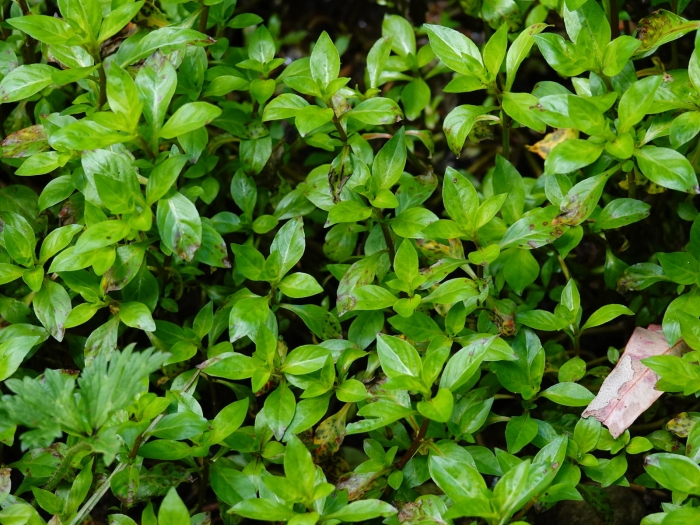Marsh Seedbox
(Ludwigia palustris)
Marsh Seedbox (Ludwigia palustris)
/
/

Jacqui Geux
CC BY 4.0
Image By:
Jacqui Geux
Recorded By:
Copyright:
CC BY 4.0
Copyright Notice:
Photo by: Jacqui Geux | License Type: CC BY 4.0 | License URL: http://creativecommons.org/licenses/by/4.0/ | Rights Holder: Jacqui Geux | Publisher: iNaturalist | Date Created: 2020-12-12T12:02:24-08:00 |
















Estimated Native Range
Summary
Ludwigia palustris, commonly known as marsh seedbox, is a perennial herb that is typically found in a variety of wetland habitats, including marshes, swamps, ditches, and along the edges of ponds and streams. It is native to a wide range of regions including North America, Central America, South America, Europe, Africa, and Asia. This plant has a creeping growth habit and can form dense mats on mud or float on the surface of the water. It reaches a height of 4-16 inches (10-40 cm) and has a spread that can be quite extensive due to its mat-forming tendency. The leaves of Ludwigia palustris can vary in color from green to red or purple, adding to its ornamental value. It produces small, inconspicuous yellow flowers with four petals, typically blooming from June to August, followed by tiny green sepals in the leaf axils.
Marsh seedbox is valued for its ability to provide cover for aquatic wildlife and its use in water gardens and aquariums for its attractive foliage. It is relatively easy to maintain, requiring consistently wet or flooded soil conditions and full sun to part shade. While it can be a beneficial plant in its native habitat, Ludwigia palustris can become invasive in areas outside its native range, where it can outcompete native vegetation and alter wetland ecosystems. Gardeners should be cautious about introducing it to natural water bodies where it is not native. In cultivation, it is important to control its spread to prevent it from becoming problematic.CC BY-SA 4.0
Marsh seedbox is valued for its ability to provide cover for aquatic wildlife and its use in water gardens and aquariums for its attractive foliage. It is relatively easy to maintain, requiring consistently wet or flooded soil conditions and full sun to part shade. While it can be a beneficial plant in its native habitat, Ludwigia palustris can become invasive in areas outside its native range, where it can outcompete native vegetation and alter wetland ecosystems. Gardeners should be cautious about introducing it to natural water bodies where it is not native. In cultivation, it is important to control its spread to prevent it from becoming problematic.CC BY-SA 4.0
Plant Description
- Plant Type: Herb
- Height: 0.25-1 feet
- Width: 3-4 feet
- Growth Rate: Moderate, Rapid
- Flower Color: N/A
- Flowering Season: Spring, Summer, Fall
- Leaf Retention: Deciduous
Growth Requirements
- Sun: Full Sun, Part Shade
- Water: High, Aquatic
- Drainage: Fast, Medium, Slow
Common Uses
Low Maintenance, Water Garden
Natural Habitat
Native to a wide range of regions including North America, Central America, South America, Europe, Africa, and Asia, and found in wetland habitats such as marshes, swamps, ditches, and pond edges
Other Names
Common Names: Marsh Seedbox, Marsh Purslane, Marsh Ludwigia, Water Purslane
Scientific Names: , Ludwigia palustris, Dantia palustris, Dantia palustris, Isnardia ascendens, Isnardia ascendens, Isnardia nitida, Isnardia palustris, Isnardia palustris f. submersa, Isnardia palustris f. terrestris
GBIF Accepted Name: